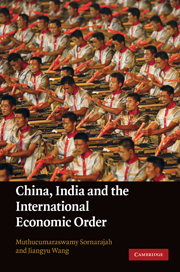Book contents
- Frontmatter
- Contents
- Notes on contributors
- Preface
- Introduction and overview
- PART I China, India and the global trade system
- 1 The WTO and development policy in China and India
- 2 China, India and developing countries in the WTO
- 3 China–India cooperation, South–South coalition and the new international economic order
- 4 India, China and foreign investment
- 5 China, India and WTO Law
- 6 China, India and the WTO dispute settlement system
- 7 China, India and dispute settlement in the WTO and RTAs
- 8 China, India and global outsourcing of services under GATS
- 9 International dispute settlement
- PART II China, India and regional economic integration in Asia
- PART III Law and development in China and India: Domestic issues
- Index
- References
7 - China, India and dispute settlement in the WTO and RTAs
from PART I - China, India and the global trade system
Published online by Cambridge University Press: 03 May 2011
- Frontmatter
- Contents
- Notes on contributors
- Preface
- Introduction and overview
- PART I China, India and the global trade system
- 1 The WTO and development policy in China and India
- 2 China, India and developing countries in the WTO
- 3 China–India cooperation, South–South coalition and the new international economic order
- 4 India, China and foreign investment
- 5 China, India and WTO Law
- 6 China, India and the WTO dispute settlement system
- 7 China, India and dispute settlement in the WTO and RTAs
- 8 China, India and global outsourcing of services under GATS
- 9 International dispute settlement
- PART II China, India and regional economic integration in Asia
- PART III Law and development in China and India: Domestic issues
- Index
- References
Summary
You should respect each other and refrain from disputes; you should not, like water and oil, repel each other, but should, like milk and water, mingle together.
– Buddha (Johannes P. Schade, Encyclopedia of World Religions (Foreign Media Group, Inc., 2006))Introduction
India's population is approximately 1.1 billion while that of China is approximately 1.3 billion. Together, they comprise more than a third of the world's population and a formidable economic pair in the developing world.
China and India share several characteristics. Both have great ancient civilizations of rich and long-standing cultures. Parts of their populations share common religious traditions. In the international arena, China and India together forged the Five Principles of Peaceful Coexistence in the 1950s, which still strongly influence developing state relations today. However, the two also diverge in many ways.
Unlike India, China is emerging from its chrysalis of a centrally planned economy and transforming into a ‘socialist market economy’. As part of this transformation, its legal system, belonging to the civil law tradition, has been undergoing massive changes in recent years – many of which are a result of its entering the World Trade Organization (WTO). In terms of rule of law, China has a greater challenge in overcoming perceptions about the strength and soundness of its legal system and adherence to the rule of law. Enormous changes have been made to China's legal system in the wake of WTO membership. Some of these changes are of watershed significance, for they spell departures from prior tradition and practice.
- Type
- Chapter
- Information
- China, India and the International Economic Order , pp. 250 - 276Publisher: Cambridge University PressPrint publication year: 2010
References
- 1
- Cited by



